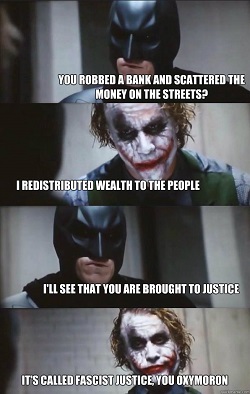|
TRANSLATE THIS ARTICLE
Integral World: Exploring Theories of Everything
An independent forum for a critical discussion of the integral philosophy of Ken Wilber
 Joe Corbett has been living in Shanghai and Beijing since 2001. He has taught at American and Chinese universities using the AQAL model as an analytical tool in Western Literature, Sociology and Anthropology, Environmental Science, and Communications. He has a BA in Philosophy and Religion as well as an MA in Interdisciplinary Social Science, and did his PhD work on modern and postmodern discourses of self-development, all at public universities in San Francisco and Los Angeles, California. He can be reached at [email protected]. Joe Corbett has been living in Shanghai and Beijing since 2001. He has taught at American and Chinese universities using the AQAL model as an analytical tool in Western Literature, Sociology and Anthropology, Environmental Science, and Communications. He has a BA in Philosophy and Religion as well as an MA in Interdisciplinary Social Science, and did his PhD work on modern and postmodern discourses of self-development, all at public universities in San Francisco and Los Angeles, California. He can be reached at [email protected].
SEE MORE ESSAYS WRITTEN BY JOE CORBETT Overcoming the Lazy-man's Guide to Integral Theory and Practice with JusticeJoe Corbett
Hence, the real justice of our system is plutocracy and debt-servitude, not to mention racism and sexism.
Perhaps the most frequently repeated phrase within the integral lexicon is the True, the Beautiful, and the Good, otherwise known as the archetypal equivalents of the Big Three. This phrase is repeated over and over in the writings of integral adherents from Integral-Life to Integral World, with literally dozens of essays right here at integralworld repeating the words as if there was a room full of parrots, or perhaps just mechanical robots, programmed to do only as their master tells them. The Big Mystery is why anybody rather than nearly everybody familiar with the AQAL cites the dogma of the Big Three and its corresponding archetypes of Truth, Beauty, and Goodness, when it is axiomatic that there are not three quadrants, but four. The simple answer to this is that Ken Wilber has for whatever reason misarticulated his own model, and being the charismatic cultish figure he is, followers simply repeat, ad nauseam, whatever KW says. I have heard people who use this phrase actually say it's a shorthand way of naming the basic pillars of existence, the ones Plato spoke of. Now, anyone familiar with Plato knows that he equally spoke about Justice, as a particular (hierarchal) relation between the parts of society. And if you want to argue that Truth, Beauty, and Goodness are an abbreviated heuristic for Truth, Beauty, Goodness, and Justice, in other words, that reducing the Big Four to the Big Three is a convenient short-cut, then I have to say you are either the laziest person on the planet, or you are simply deceiving yourself in order to graft the doctrine of the Holy Trinity onto integral theory. Why four archetypes should be abbreviated to three defies all logic and reason, and it only makes sense as an irrational element in consciousness that desires and seeks to conceal the reality of the excluded and repressed from itself and others. 
Most people probably don't realize that by repeating this “abbreviated” phrase over and over they are collectively pushing one-quarter of the AQAL into the socio-political unconscious, and at a time when the substance of Justice is at a critical point in history. The theme of the 2015 ITC as to whether the AQAL has any real-world impact on social transformation, needs to look no further than why the LR quadrant of Justice has been systematically excluded, whether consciously or unconsciously, by the collective articulations of the integral community. For those uninterested in such a question, and I know there are some, I might suggest another phrase for them to start practicing, namely, “Polly want a cracker?” Any integral metatheory that wants to have an impact on the world today and yet continues to pronounce it's loyalty to the True, the Beautiful, and the Good without mention of Justice alongside these pillars, is like a theory of capitalism that talks about management, profits, and stockholders without any mention of labor. That kind of analysis will change nothing but how the status quo itself can be reinforced and business as usual perpetuated. The content of any metatheory must itself be complete, as well as oriented to changing the locks on the doors of its own perception (when needed) with a critical eye turned upon itself. Indeed, sometimes I feel like I'm in the FOX-news zone with my efforts to keep Justice on the radar of the integral community, and it makes me wonder if certain elements have slipped into their own kind of fundamentalist belief system, or into an iron cage of institutional routinization after the initial articulation of its founder, without self-reflexive capacity. Some people do seem to work very hard to exclude Justice as a key term of the AQAL alongside and equal to Truth, Beauty, and the Good, which integral theory has done from its inception. This kind of reminds me of how Republicans have been instructed not to mention the word capitalism in their speech because naming things, or not naming them, is a key to the framing of the system of thought you want to create. So what kind of frame of thinking is being created by excluding Justice from the AQAL? 
For those who think I have a misunderstanding of justice because justice is an aspect of the Good, let me show you why it is you who is mistaken. Justice as a community (or individual) defines it, this way or that, is not Justice at all, but rather is indeed the communities (individuals) definition of the good/not good. However this is to be distinguished from Justice as an archetypal category in and of itself, which is an interobjectively measurable value of power and influence between the parts of a system (law, politics, economics, military strategy, gender class and ethnic relations, etc.). Hence, the real justice of our system is plutocracy and debt-servitude, not to mention racism and sexism, whereas democracy and liberty and equality is the imaginary ideology of the bourgeoisie. In other words, to repeat, actual justice is not what a particular community defines it as, but rather is the real, actual, and concrete interobjective relations between the parts of a system, and these relations need to be a systematic focus of our attention, not as an adjunct to intersubjective or subjective interpretations. Moreover, the quickest way to make a theory irrelevant and ineffective is to systematically render it blind and invisible to the most important issue of the times, namely, justice, which is exactly what integral theory has done and continues to do. Hence, integral theory continues to operate on 3 cylinders of an engine designed with 4 cylinders, which is not a good way to get off the ground and running. Justice deserves its own quadrant, and this matters in how integral theory is translated into the world of actions. If you don't get the formula correct, you won't get the practical results. It matters a great deal if the AQAL does or does not use Justice as the fourth archetypal category, just as it matters a great deal whether we have the vocabulary to name the current regime of capitalism as neoliberalism. Without a name and a handle there is no possibility of awareness, critique, and transformation, and hence no evolution. Certainly, the attempt to bury justice as a visible element of the AQAL might be seen as a strategy to eliminate the influence of green, and the MGM in particular, within integral theory, either consciously or unconsciously. But if there is one thing that many people have been unsatisfied with regarding integral theory it's the lack of a political-justice component, a lack that has been explicitly written out of the AQAL, and which can be remedied by including Justice as the LR category. In an unlikely scenario of concession to critique, will the charismatic founder of integral theory give Justice his stamp of approval, or is the integral community capable of moving-on beyond his articulation of the Big Three with the Big Four of Truth, Beauty, Goodness, and Justice?
|